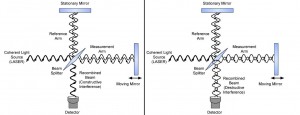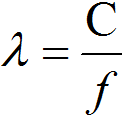Go back to:-
The current definition of the metre is the distance traveled by light in a vacuum during 1⁄299,792,458 of a second. The definition of the metre is used to make measurements using laser interferometers.

Lasers produce light which is all in phase, this is known as coherent light and is ideal for use in a measurement interferometer. The simplest form of interferometer is described here, known as a Michelson interferometer after its inventor. The laser light is directed at a beam splitter which causes approximately half of the light to be redirected along the reference arm and the remaining half to continue along the measurement arm. Mirrors at the end of each arm return the light and the beam splitter causes it to be recombined with approximately 50% of the recombined beam directed towards the detector and the remaining light directed back towards the source. If the light from the reference arm and the measurement arm is exactly in phase then there will be constructive interference and a strong signal will be detected. If on the other hand there is a phase difference of 180° between the reference arm and the measurement arm then there will be destructive interference and the signal at the detector will be close to zero.
When the moving mirror is moved along the axis of the measurement arm the recombined beam moving in and out of interference will cause a sinusoidal variation in intensity at the detector. Since the light travels in both directions along the measurement arm the sensitivity to movement is doubled. This means that one complete cycle, from maximum intensity, through minimum intensity, and back to maximum, will occur when the moving mirror moves by one half of the wavelength of the light.
In order to measure one metre using the fundamental definition of the meter we must know the frequency of the light source (f) and the speed of light for the medium though which the light will propagate (C). The wavelength of the light source (λ) is then found using the wave equation

To measure a length L moving mirror should be moved while counting N peak intensity fringes at the detector where N is given by

If a resolution of less than half the wavelength is required then the intensity of the signal between the minimum and maximum values can be used to determine the correct position of the moving mirror.
Read more about:-
- Angle Measurement
- Metrology introducing the concepts of uncertainty, traceability and confidence, and explaining how this allows us to prove, with known statistical confidence, whether or not something conforms to a specification.
- An introduction to evaluating uncertainty of measurement.